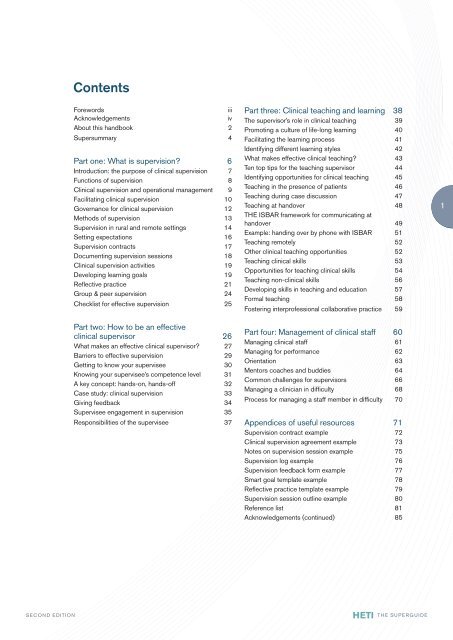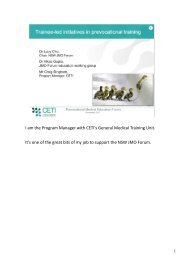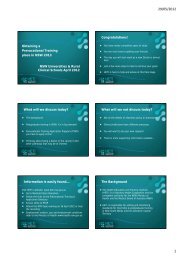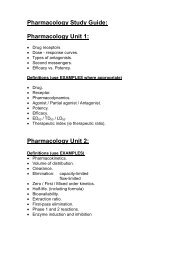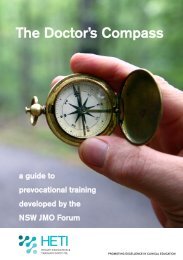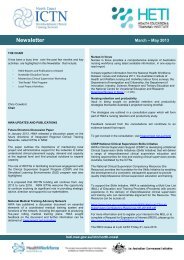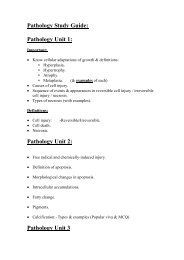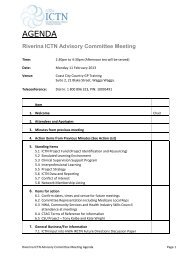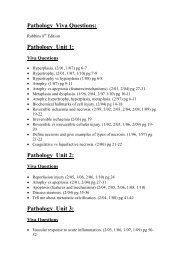a handbook for supervising allied health professionals - HETI - NSW ...
a handbook for supervising allied health professionals - HETI - NSW ...
a handbook for supervising allied health professionals - HETI - NSW ...
Create successful ePaper yourself
Turn your PDF publications into a flip-book with our unique Google optimized e-Paper software.
Contents<br />
Forewords<br />
Acknowledgements<br />
SECOND EDITION<br />
iii<br />
iv<br />
About this <strong>handbook</strong> 2<br />
Supersummary 4<br />
Part one: What is supervision 6<br />
Introduction: the purpose of clinical supervision 7<br />
Functions of supervision 8<br />
Clinical supervision and operational management 9<br />
Facilitating clinical supervision 10<br />
Governance <strong>for</strong> clinical supervision 12<br />
Methods of supervision 13<br />
Supervision in rural and remote settings 14<br />
Setting expectations 16<br />
Supervision contracts 17<br />
Documenting supervision sessions 18<br />
Clinical supervision activities 19<br />
Developing learning goals 19<br />
Reflective practice 21<br />
Group & peer supervision 24<br />
Checklist <strong>for</strong> effective supervision 25<br />
Part two: How to be an effective<br />
clinical supervisor 26<br />
What makes an effective clinical supervisor 27<br />
Barriers to effective supervision 29<br />
Getting to know your supervisee 30<br />
Knowing your supervisee’s competence level 31<br />
A key concept: hands-on, hands-off 32<br />
Case study: clinical supervision 33<br />
Giving feedback 34<br />
Supervisee engagement in supervision 35<br />
Responsibilities of the supervisee 37<br />
Part three: Clinical teaching and learning 38<br />
The supervisor’s role in clinical teaching 39<br />
Promoting a culture of life-long learning 40<br />
Facilitating the learning process 41<br />
Identifying different learning styles 42<br />
What makes effective clinical teaching 43<br />
Ten top tips <strong>for</strong> the teaching supervisor 44<br />
Identifying opportunities <strong>for</strong> clinical teaching 45<br />
Teaching in the presence of patients 46<br />
Teaching during case discussion 47<br />
Teaching at handover 48<br />
THE ISBAR framework <strong>for</strong> communicating at<br />
handover 49<br />
Example: handing over by phone with ISBAR 51<br />
Teaching remotely 52<br />
Other clinical teaching opportunities 52<br />
Teaching clinical skills 53<br />
Opportunities <strong>for</strong> teaching clinical skills 54<br />
Teaching non-clinical skills 56<br />
Developing skills in teaching and education 57<br />
Formal teaching 58<br />
Fostering interprofessional collaborative practice 59<br />
Part four: Management of clinical staff 60<br />
Managing clinical staff 61<br />
Managing <strong>for</strong> per<strong>for</strong>mance 62<br />
Orientation 63<br />
Mentors coaches and buddies 64<br />
Common challenges <strong>for</strong> supervisors 66<br />
Managing a clinician in difficulty 68<br />
Process <strong>for</strong> managing a staff member in difficulty 70<br />
Appendices of useful resources 71<br />
Supervision contract example 72<br />
Clinical supervision agreement example 73<br />
Notes on supervision session example 75<br />
Supervision log example 76<br />
Supervision feedback <strong>for</strong>m example 77<br />
Smart goal template example 78<br />
Reflective practice template example 79<br />
Supervision session outline example 80<br />
Reference list 81<br />
Acknowledgements (continued) 85<br />
<strong>HETI</strong><br />
THE SUPERGUIDE<br />
1


